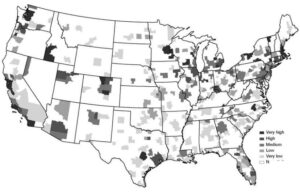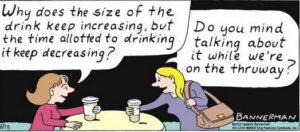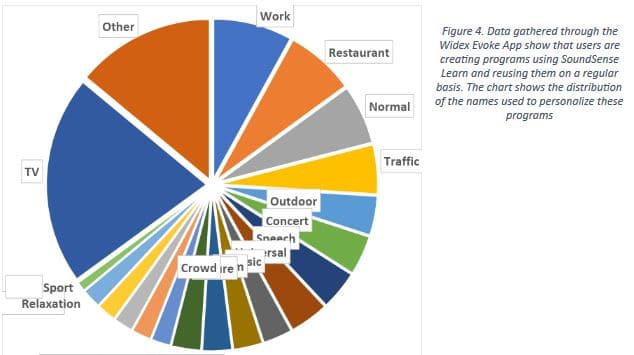International Coffee Day, September 29, is when Economists and entrepreneurs give it up to openly worship Productivity by coffee proxy. Services are open to all Audiologists.
Hearing Economics’ annual coffee celebration commences today by ferreting out caffeine/coffee connections to our pursuit of Audiology success and prosperity, saving health and happiness for next week.
Success and Prosperity
Success means a lot of things, one being the economic measure of wealth. Wealth, in turn, can be predicted by measures of productivity.
“Only productivity growth can make a country rich.” Nobel Prize Economist Paul Krugman
Technological innovation increases productivity and is therefore a measure of success. But how does one measure a complicated, intermittent, geographically diverse concept like Innovation?
Using Proxy Variables to Predict Innovation
Hearing Economics’ Technology Hypothesis of Coffee asserted, tongue-in-cheek, that “coffee is an essential component powering technological advance, if for no other reason than it keeps people awake long enough to get the job done.” By that reasoning, more waking hours should result in more Innovation. Perhaps that’s the case, but not always and not always due to coffee.
Other variables such as advanced education/training and R&D dollars are more strongly associated with innovation. But how strongly? And how do you separate the effects of education from research dollars on Innovation? After all, many of us with advanced educations owe our good fortune to scholarships funded by research dollars.
The variables are “confounded,” meaning that education really does influence Innovation but the magnitude of the association is influenced by another variable, research dollars (and vice versa). It’s a natural, chicken and egg dilemma that can’t be completely eliminated with statistical tinkering, so you can never use those variables to measure/predict Innovation directly. This is where “proxy variables” come in handy, including coffee.

Fig 1. Patents per capita in US metropolitan areas (map 1, Moretti, 2013)
Proxy variables are unrelated (not confounded) variables used to estimate something you can’t measure directly. In the case of Innovation, economists like Enrico Moretti at UC Berkeley{{1}}[[1]]Moretti, E. The New Geography of Jobs. NY: Houghton Mifflin Harcourt (2013).[[1]] have nominated patents as an indirect “proxy variable” for innovation. Patents are not innovation itself, but they’re similar and countable.
In Figure 1, patent activity clusters closely to a few geographic locales in the US, the same locales where wealth/productivity clusters occur.{{2}}[[2]]See Moretti for more maps and discussion supporting the patent-productivity-wealth connections.[[2]] Moretti’s analyses ends up demonstrating the important finding that Universities are not the reason Innovation happens; instead, entrepreneurial companies move near Universities to gain resources. Likewise, R&D dollars cluster in entrepreneurial enclaves (e.g., Silicon Valley).
In the end, patents as proxies show that advanced education and research dollars are necessary but not sufficient for Innovation. It’s entrepreneurship that drives Innovation which gives us Productivity and Prosperity.
Wake Up and Shake Your Coffee Proxy
Like the patent industry, the coffee industry is entrepreneurial and makes big money. In worldwide commodity trading, coffee is second only to oil, ringing up $100 billion annually. Ninety percent of the world’s population uses caffeine in one form or another. Might coffee predict Innovation, just as patents do?
Compare the patent distribution of Figure 1 with the distribution of Starbucks stores in the US (Figure 2). The maps overlay with little variance, suggesting Starbucks as an excellent proxy variable for geographically distributed patents and, therefore, regional innovation. Skeptics and tea drinkers can click on another map that plots a variety of coffee chains and overlays Figure 1 in similar fashion. The more coffee there is in a given place, the more productive, innovative, and prosperous that place is.
Ta da! Move near a Starbucks, feel your innovative juices flow, watch your practice’s productivity and prosperity grow. Some entrepreneurs recommend making Starbucks your office, though noise levels and HIPAA regulations argue against this strategy for Audiology practices. Nevertheless, coffee proximity predicts prosperity, as measured by patents which predict innovation. If that sentence confuses you, have another cup of coffee and try again.{{3}}[[3]]This is NOT the vaunted “Starbucks effect” which is limited to a single industry, but innovation is key there as well.[[3]]
Productivity Cries for Coffee and More Maps
 Productivity is the ratio of output to inputs, often expressed as GDP per hours worked. The higher the output per labor and capital inputs, the higher the productivity. Audiology dispensing practices with the highest service/product output per overhead are, by definition, the most productive and therefore the most competitive. Likewise, manufacturers that produce the most technologically advanced instruments with greatest efficiency have a competitive edge in the market. Simply put, the one who does the most with the least wins, which requires constant innovation.
Productivity is the ratio of output to inputs, often expressed as GDP per hours worked. The higher the output per labor and capital inputs, the higher the productivity. Audiology dispensing practices with the highest service/product output per overhead are, by definition, the most productive and therefore the most competitive. Likewise, manufacturers that produce the most technologically advanced instruments with greatest efficiency have a competitive edge in the market. Simply put, the one who does the most with the least wins, which requires constant innovation.
The “jobless” recovery that’s followed the Great Recession illustrates the effects of innovation on productivity and employment. At present, the US is logging 2.522 trillion hours of work annually, most of it in the private sector. Productivity is rising and jobs are going to those who propel or support knowledge, ideas, and innovation. I hope Audiologists and others in the hearing aid industry are taking heed and contributing to that innovation/productivity momentum. Paraphrasing Paul Krugman, only productivity growth can make Audiologists and hearing aid manufacturers rich. No wonder we need our coffee!
I think I could get a good feel for how innovative we are if only I had a Figure 3 that showed the distribution of Audiology dispensing practices in the US. How might it overlay with Figures 1 and 2? Are our offices close enough to Starbucks and patent producers? Are we maximizing our productivity through strategic selection of office locations? Why don’t we have an app for that? What our dues-paying profession needs is membership organizations that give us these kind of visual aids with frequent updates. ASHA, AAA, ADA, please contact Google Maps immediately and get us on the app map!
And please call Starbucks while you’re at it. Maybe they’re interested in forming a strategic alliance now that coffee has been linked to tinnitus reduction. That story and other research linking coffee/caffeine to health measures form next week’s topic.
images courtesy of Isabella Bannerman; Starbucks map courtesy of caffeine maps







